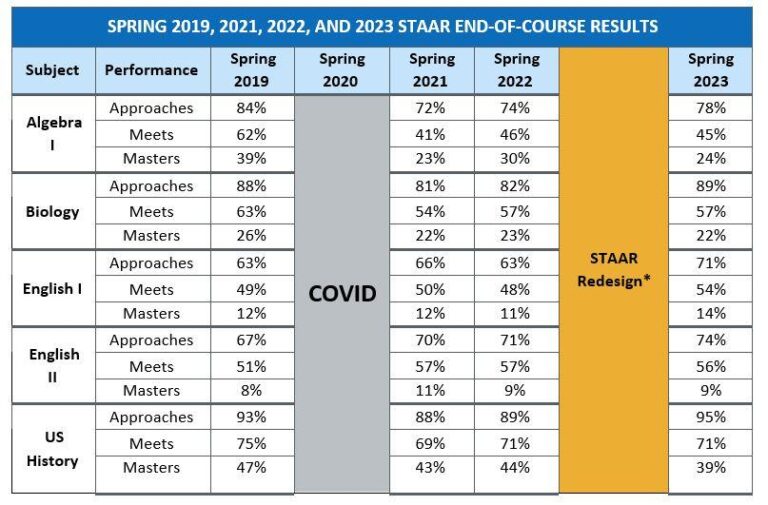Texas High School STAAR Results Reveal Divergent Trends in English and U.S. History
Significant Gains in English Language Arts Among Texas High Schoolers
Recent STAAR assessment data indicates that Texas high school students have made commendable strides in English Language Arts (ELA), with proficiency rates climbing by approximately 5 percentage points compared to last year. This upward trend is largely credited to the adoption of innovative reading comprehension initiatives and focused writing skill workshops implemented across various school districts. Additionally, the expansion of Advanced Placement (AP) and dual-credit English courses has equipped students with stronger analytical and writing capabilities, contributing to their improved test outcomes.
Despite these encouraging developments in ELA, the same period saw a downturn in U.S. History scores, signaling a need for renewed attention to social studies education. Below is a comparative overview of proficiency percentages for both subjects:
| Subject | 2023 Proficiency Rate | 2022 Proficiency Rate | Percentage Change |
|---|---|---|---|
| English Language Arts | 72% | 67% | +5% |
| U.S. History | 58% | 62% | -4% |
- Enhanced ELA curricula and instructional methods credited for progress
- Declining U.S. History results highlight engagement challenges
- State education leaders planning increased support for social studies educators
Concerns Mount Over Falling U.S. History Scores
Educators statewide are expressing alarm over the recent dip in U.S. History proficiency among high school students, as revealed by the latest STAAR results. While English Language Arts has seen steady improvement, history scores have either plateaued or decreased in numerous districts. Contributing factors include reduced instructional time for social studies, shifting curricular priorities, and the ongoing difficulties of hybrid and remote learning environments.
To counteract this decline, school leaders are advocating for targeted strategies such as:
- Specialized professional development to equip history teachers with engaging pedagogical techniques.
- Curriculum adjustments to emphasize essential historical themes and critical thinking.
- Investment in interactive learning tools like digital archives and immersive technology to enliven history lessons.
Several districts have launched pilot programs designed to spark student interest and improve achievement in social studies, with early indicators showing promise.
| Subject | 2023 Average Score | Change Since 2022 |
|---|---|---|
| English Language Arts | 78% | +3% |
| U.S. History | 65% | -4% |
Understanding the Causes Behind Subject-Specific Performance Variations
Educational experts attribute the contrasting STAAR outcomes in English and U.S. History to several underlying factors. The depth and consistency of curriculum delivery differ markedly between these subjects, with English programs benefiting from sustained integration and resource investment across grade levels. Conversely, U.S. History instruction often contends with compressed schedules and evolving state standards, which can impede thorough comprehension.
Moreover, disparities in student engagement and access to learning materials play a crucial role. English classes frequently enjoy richer resources and innovative teaching approaches, while history courses may lack similar support. Socioeconomic influences further compound these differences; students in well-funded districts tend to outperform peers due to greater availability of tutoring, enrichment programs, and parental involvement.
| Subject | Average Student Score | Level of Resource Availability |
|---|---|---|
| English Language Arts | 85% | High |
| U.S. History | 70% | Moderate |
To bridge these gaps, experts recommend:
- Boosting funding for history education to enhance instructional materials and teacher training.
- Developing engaging, relevant curricula that link historical events to contemporary issues.
- Expanding professional development opportunities focused on innovative teaching strategies for social studies.
Strategies to Revitalize U.S. History Education and Student Achievement
Addressing the downturn in U.S. History performance requires schools to adopt more dynamic and relatable teaching resources. Incorporating multimedia content, hands-on projects, and community engagement activities can help students connect historical lessons to their own lives, fostering deeper interest and understanding. Equipping educators with professional development centered on critical analysis and source evaluation will further enhance instructional effectiveness.
Additionally, strengthening support systems for students struggling in history is vital. Initiatives such as peer tutoring, study groups, and personalized feedback can improve comprehension and retention. The following table outlines key initiatives designed to elevate U.S. History learning outcomes:
- Expanded classroom resources: Interactive textbooks, virtual museum tours, and digital archives
- Collaborative teacher networks: Cross-district workshops and shared best practices
- Early intervention programs: Identifying and supporting at-risk students promptly
- Parental involvement: Workshops and resources to assist history learning at home
| Initiative | Expected Benefit | Projected Implementation Timeline |
|---|---|---|
| Digital History Labs | Enhances student engagement through technology integration | 6 months |
| Comprehensive Teacher Training | Improves instructional quality and student outcomes | 1 year |
| Peer Tutoring Programs | Offers tailored academic support | Ongoing |
Conclusion: Balancing Progress and Challenges in Texas High School Education
The latest STAAR results from Texas high schools reveal a promising rise in English Language Arts achievement alongside a concerning decline in U.S. History proficiency. This divergence underscores the necessity for educators and policymakers to recalibrate instructional priorities and resource distribution. By implementing targeted interventions, enhancing teacher support, and fostering student engagement in history, Texas can work toward elevating academic performance across all disciplines. Ongoing evaluation and adaptive strategies will be essential to ensure equitable educational success for every student in the years ahead.







